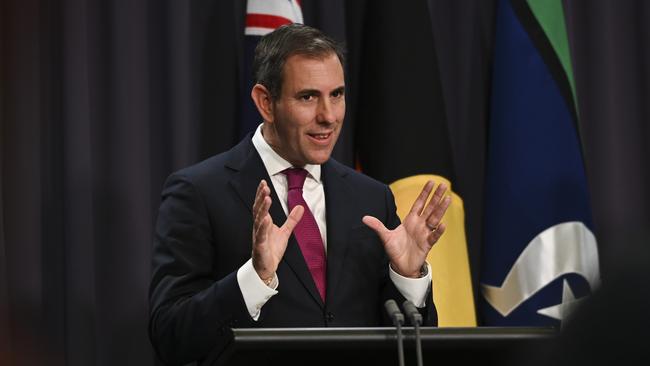Rising iron ore pricesto help Chalmers’ budget again
The federal treasurer could be headed for another pleasant financial surprise next year as iron ore prices sit back around $US120 a tonne, well ahead of budget expectations.
Federal Treasurer Jim Chalmers could be headed for another pleasant budget surprise next year as iron ore prices sit back around $US120 ($186.34) a tonne, well ahead of budget expectations.
Last week’s final budget figures show the tax office raked in $153.16bn in company taxes – $12.4bn ahead of budget expectations, mostly off the back of stronger commodity prices in iron ore and coal, with a minor contribution from soaring lithium prices.
That helped deliver a $22.1bn cash surplus for the fiscal year, $17.9bn ahead of expectations and, while Mr Chalmers was keen to play down the chances of a repeat performance in the current year, commodity prices suggest the next year’s budget will also look a lot better than expected.
Mr Chalmers’ May budget tipped iron ore prices to fall to an average $US60 a tonne by March 2024, sold at the port, rather than $US55 a tonne used in the previous budget in October 2022.
But iron ore has sat stubbornly above $US100 a tonne – delivered to China – for most of the financial year so far, lifting above $US120 a tonne last week as Chinese steel mills began restocking ahead of week-long holidays at the end of September, traditionally a strong month for iron ore pricing.

Analysts say markets are also potentially pricing in renewed stimulus measures in China, which could hold back Beijing’s threatened move to curb steel output in the second half of the year.
Fitch Ratings’ BMI forecasting unit last week tipped iron ore prices to average $US110 through 2023 with “strong risks to the upside”, and forecast average prices of $US100 a tonne through 2024.
“Despite the mainland Chinese property sector still being in contraction, positive sentiment is stemming from hopes of a turnaround, with some form of stimulus from the mainland Chinese government,” Fitch analysts said.
JP Morgan analysts recently upgraded their 2024 expectations to $US110 a tonne average price, and BHP noted when delivering its annual financial results that marginal iron ore suppliers were leaving the seaborne market when prices dipped below $US100 a tonne with “any dips below that threshold unable to persist for any meaningful length of time”.
All of that suggests that treasury’s iron ore forecasts are again likely to come in wildly below the actual market price. Even factoring in freight at $US10 a tonne delivered to China, most analyst forecasts now suggest iron ore to average around $US90 for the fiscal year – substantially ahead of the budget forecast.
The May budget forecast a $13.9bn deficit in 2023-24. Every additional $US10 a tonne on top of the assumed iron ore price would deliver an additional $500m to the treasury coffers, the budget papers say.




To join the conversation, please log in. Don't have an account? Register
Join the conversation, you are commenting as Logout